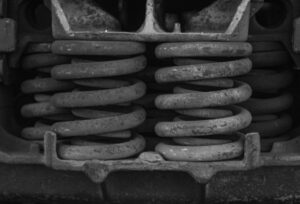 In the history of springs, it’s no exaggeration to state that spring technology has been around since the dawn of civilization. Look no further than the bow and arrow. One of the earliest applications of spring technology, the taut string of a bow has stored and released the mechanical energy required to provide food and protection for 64,000 years. Like non-coiled spring applications were used as suspension systems to absorb shock for chariots in ancient Egypt. Similar leaf springs were used on Roman two-wheeled vehicles. The modern leaf spring was introduced in the eighteenth century by the French nobility for their carriages. The arc-shaped plate fixed under a carriage to better hold the weight is considered the first for transportation vehicles.
In the history of springs, it’s no exaggeration to state that spring technology has been around since the dawn of civilization. Look no further than the bow and arrow. One of the earliest applications of spring technology, the taut string of a bow has stored and released the mechanical energy required to provide food and protection for 64,000 years. Like non-coiled spring applications were used as suspension systems to absorb shock for chariots in ancient Egypt. Similar leaf springs were used on Roman two-wheeled vehicles. The modern leaf spring was introduced in the eighteenth century by the French nobility for their carriages. The arc-shaped plate fixed under a carriage to better hold the weight is considered the first for transportation vehicles.
Though coiled springs do not have the lineage of non-coiled springs, the use of spiral wire objects can be traced back for thousands of years. Archaeologists have discovered ancient, coiled helical-shaped spring-like wire objects in the Balkans and across Europe that can be dated to 4,000 BC. However, the first coiled springs did not appear until the late Middle Ages in Europe. Early applications included door locks and the spring powered-clocks that are still found in towers presiding over villages, towns, and cities throughout the continent. By the 16th century, coil springs appeared in the first large watches.
Hooke’s Law
The evolution of spring technology and the elasticity of objects moved forward when, in 1678, British physicist, Robert Hooke, advanced the principle of physics that bears his name. Hooke’s Law explained the elasticity of solid bodies, which further led to the discovery of how tension increases and decreases in a spring coil proportional to the load applied to it—as long as the load does not exceed the elastic limit of the material. Hooke’s Law applied to the elastic limit of material and became of prime importance in the advancement of the components used in countless devices, machines and equipment.
Coil Spring Introduction
The coil spring as we know it today was patented by Richard Tredwell in 1763. Considered revolutionary at the time, it introduced a new era in spring technology that has continued to advance through the present day. Tredwell received Great Britain Patent 792 for “Springs For Carriages”. The full patent was four pages, which included nine iterations of a helical suspension system that clearly stated, “my new method of making and constructing springs for the hanging of coaches”. With the introduction of the coil spring, new types of spring technology developed, from balance springs to improved clock springs and mattress springs. Inexpensive to replace and far more accurate, the new coiled springs were an improvement over leaf springs which had to be separated and constantly lubricated to maintain properly.
In less than a century, Tredwell’s coil spring would prove instrumental in the industrial revolution with the development of the steel coil spring, which, in 1857, was first patented in America for use in chair seats. The coil spring was placed in the innerspring mattress in 1871 by German inventor Heinrich Westphal.
Mass Production of Springs
In addition to mass-produced furniture, the industrial revolution paved the way for the mass production of springs and their wider applications. Coiled springs were introduced in the manufacture of machines, equipment to manufacture machines, and were vital in the development of the transportation revolution with the first trains, and eventually cars and airplanes. Whether keeping a door open or closed to absorbing shocks in cars or trains and even baby carriages, spring applications were quickly adapted.
Springs soon found their way into applications for entertainment purposes, too. Such items as the familiar pogo stick and trampoline, and even Richard James’s invention of the Slinky in 1943, all rely on the coiled spring.
The advancement of spring technology can be found everywhere today in the application of compression, extension and torsion springs. Found in countless devices and equipment across every industrial sector, from aerospace, automotive, and manufacturing to medical equipment, electronics, and construction, the coiled spring continues to evolve in leaps and bounds.
Custom Spring Design
James Spring and Wire Company has successfully partnered with fabricators, engineers, and design firms alike in the design and manufacture of custom springs. Our in-house engineering department can help you with your design to ensure that your specifications are met and the best, quality spring is manufactured for your application. To learn more contact James Spring and Wire today.

